The Potty Training and Step Stools Market is estimated to be valued at USD 250.3 million in 2025 and is projected to reach USD 370.5 million by 2035, registering a compound annual growth rate (CAGR) of 4.0% over the forecast period.
Between 2025 and 2028, growth remains consistent, moving from USD 260.3 million to USD 281.5 million, signaling moderate expansion. A sharper increase is visible in 2029, when the market touches USD 292.8 million, showing stronger momentum. From 2030 to 2033, the market maintains a gradual climb, advancing from USD 316.7 million to USD 342.5 million. The later period, 2034 to 2035, continues this upward curve, closing at USD 370.5 million. The year-on-year growth indicates a reliable expansion, with a global CAGR of 4.0 percent, demonstrating consistent demand from consumers.
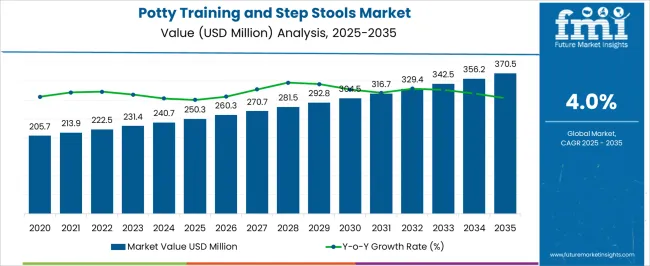
| Metric | Value |
|---|---|
| Potty Training and Step Stools Market Estimated Value in (2025 E) | USD 250.3 million |
| Potty Training and Step Stools Market Forecast Value in (2035 F) | USD 370.5 million |
| Forecast CAGR (2025 to 2035) | 4.0% |
Urbanization trends and the rise of dual-income households have accelerated the need for safe, hygienic, and user-friendly training products that reduce caregiver effort. The market has also been positively influenced by growing emphasis on child ergonomics, safety certifications, and the aesthetic appeal of products.
Manufacturers are increasingly focused on developing multi-functional, portable, and visually engaging solutions that appeal to both children and parents. Additionally, increased online retail penetration has enhanced product accessibility, facilitating broader adoption across both developed and emerging markets. Sustainability preferences are gradually shaping material choices, but functionality and durability continue to remain dominant purchase drivers.
The future outlook for this market remains positive as child health campaigns, daycare integration, and product innovations in adjustable seating and non-slip designs continue to shape consumer preferences. Regulatory attention toward non-toxic materials and safe design standards is further expected to support category expansion globally.
The potty training and step stools market is segmented by product type, material, pricing, age group, end-use, distribution channel, and geographic region. By product type, the potty training and step stools market is divided into Potty training and Step stools. In terms of material, the potty training and step stools market is classified into Plastic, Wood, and Others (polypropylene, pinewood). Based on pricing, the potty training and step stools market is segmented into Medium (15$-30$), Low (5$-15$), and High (Above 30$). By age group, the potty training and step stools market is segmented into Toddlers (2-5 years), Newborns (0-6 months), Infants (6 months- 2years), and Others (above 5 years). By end use, the potty training and step stools market is segmented into Individual use and Commercial use. By distribution channel, the potty training and step stools market is segmented into Online and Offline. Regionally, the potty training and step stools industry is classified into North America, Latin America, Western Europe, Eastern Europe, Balkan & Baltic Countries, Russia & Belarus, Central Asia, East Asia, South Asia & Pacific, and the Middle East & Africa.
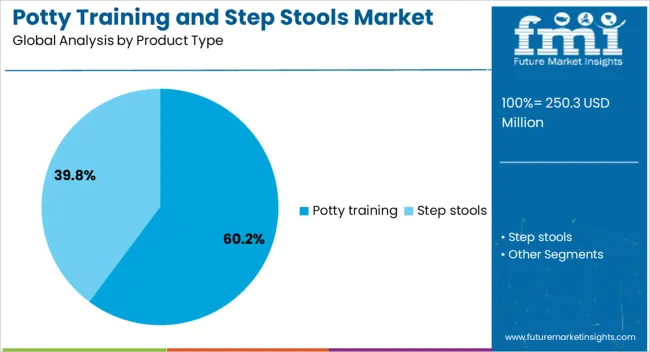
The potty training segment is projected to hold 60.2% of the total revenue share in the Potty Training and Step Stools market in 2025, making it the leading product type. This dominance has been driven by a growing preference for structured toilet training at an earlier age, particularly among urban and working parents. Demand for ergonomically designed, child-safe, and mess-free potty training solutions has been growing consistently due to the emphasis on hygiene and convenience.
The availability of child-friendly designs, compact folding structures, and easy-to-clean surfaces has encouraged widespread adoption. Manufacturers have increasingly focused on offering colorful, character-based, and reward-integrated models that improve child cooperation during the training phase.
Enhanced portability and adjustable seating options have also allowed for use across home, travel, and daycare settings, further contributing to segment growth. The use of innovative features such as splash guards, soft-grip handles, and anti-skid bases has helped build trust in product safety, reinforcing consumer confidence and leading to higher product uptake.
Plastic-based products are expected to account for 51.7% of the total revenue share in the Potty Training and Step Stools market in 2025. The popularity of plastic as a material is being supported by its lightweight, durable, and easy-to-mold properties, which are ideal for child-focused designs. Products made from plastic have been favored for their ease of cleaning, cost-effectiveness, and resistance to damage from repeated use and washing.
Enhanced capabilities in plastic molding have enabled the development of safer edges, bright colors, and non-toxic finishes that meet child safety norms. The availability of BPA-free, food-grade, and recyclable plastic variants has allowed manufacturers to align with both safety and sustainability standards.
Additionally, plastic materials have enabled the production of customizable and collapsible forms, catering to the demand for space-saving and travel-friendly solutions The ability to integrate plastic with grip-based rubber padding and surface texturing has further enhanced usability, positioning plastic as the most versatile and scalable material in this category.

Medium-priced products, within the range of 15 to 30 USD, are projected to capture 48.2% of the overall revenue share in the Potty Training and Step Stools market in 2025. This pricing tier has emerged as the most preferred among price-sensitive yet quality-conscious consumers who seek a balance between affordability and durability. Products in this segment offer functional features such as adjustable height, removable bowls, padded seats, and attractive child-centric aesthetics without a significant cost burden.
The medium pricing segment has also gained traction due to strong retailer support, bundling offers, and promotional activities targeted at first-time parents. Enhanced value-for-money perception in this tier has supported repeat purchases and gift-based buying behavior, particularly during parenting events and baby registries.
The presence of well-established brands operating in this pricing category has further ensured consistent quality and product availability. With rising consumer expectations around quality and design, the medium pricing segment is expected to maintain its leadership by delivering optimal product performance at a justifiable cost.
The potty training and step stools market is growing due to increasing awareness of child development and parents’ desire to support their children's independence. Potty training and step stools are essential tools in helping young children transition from diapers to using the toilet and reaching sinks or counters with ease. The growing number of young families, especially in emerging economies, is driving demand for these products. Innovations in design and materials, as well as an increase in consumer preference for safer and more durable products, are contributing to market growth.
The potty training and step stools market is driven by the increasing focus on child development and fostering independence. Parents are more focused than ever on helping their children develop self-sufficiency, particularly when it comes to potty training and daily activities such as washing hands. Potty training products such as seats and stools are key tools in this process, supporting children in their transition to using the toilet independently. The rise in dual-income households and urbanization, which often means smaller living spaces, is also driving the need for compact, effective, and easy-to-use potty training and step stools that can be stored conveniently.
Despite market growth, the potty training and step stools market faces challenges related to safety concerns and product quality variability. Parents are particularly concerned about the safety of products that children use regularly, especially when it comes to non-slip features, stability, and overall durability. Many products on the market may not meet the safety standards, leading to concerns about potential accidents. Furthermore, the market is crowded with a variety of options, making it difficult for consumers to identify high-quality, safe, and reliable products. Manufacturers must focus on ensuring high-quality, durable materials and adhere to strict safety guidelines to overcome these challenges and gain consumer trust.
The potty training and step stools market presents significant opportunities with the growth of online retail and ongoing product innovations. The increasing shift towards online shopping has made it easier for parents to access a wide range of products and read reviews before making purchases. This trend is particularly advantageous for the potty training and step stools market, where parents value product safety and effectiveness. Innovations in design, such as foldable stools, portable potty training kits, and adjustable height features, are offering consumers more convenience and flexibility. Manufacturers can leverage these trends to develop better, more user-friendly products that meet the evolving needs of modern families.
A key trend in the potty training and step stools market is the increasing demand for multi-functional and ergonomically designed products. Parents are looking for products that offer more than one function, such as potty training seats with built-in step stools or adjustable stools that grow with the child. Ergonomic designs that provide comfort, support, and safety are also gaining popularity. Consumers are preferring products that offer easy-to-clean features and durable materials. The shift towards more versatile, comfortable, and space-efficient products is shaping the market's direction, with manufacturers focusing on creating innovative solutions to meet these needs.
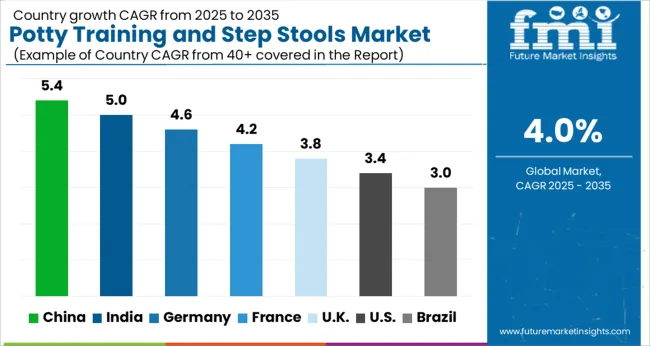
| Country | CAGR |
|---|---|
| China | 5.4% |
| India | 5.0% |
| Germany | 4.6% |
| France | 4.2% |
| UK | 3.8% |
| USA | 3.4% |
| Brazil | 3.0% |
The global potty training and step stools market is projected to grow at a global CAGR of 4.0% from 2025 to 2035. China leads the market with a growth rate of 5.4%, followed by India at 5.0%. France records a growth rate of 4.2%, while the UK shows 3.8% and the USA follows at 3.4%. The market is primarily driven by increasing demand for child development products, rising awareness of potty training, and growing disposable incomes. China and India are leading the growth, supported by rising birth rates, urbanization, and evolving parental practices. Developed markets like France, the UK, and the USA are witnessing steady growth, driven by strong product awareness and demand for high-quality, ergonomic products. The analysis spans over 40+ countries, with the leading markets shown below.
The potty training and step stools market in China is growing at a 5.4% CAGR, driven by increasing awareness among parents about child development and the rising number of young children. As the country’s middle class expands and disposable incomes increase, there is greater demand for high-quality, ergonomic training products. Urbanization and a growing preference for modern parenting practices are further supporting the adoption of potty training products and step stools. The availability of a variety of colorful, attractive designs tailored to children’s preferences is fueling the market. China’s growing population continues to contribute significantly to the market’s growth.
The potty training and step stools market in India is expected to grow at a 5.0% CAGR, supported by the country’s expanding middle class and the rising awareness of child development products. With more parents seeking efficient and comfortable solutions for potty training, demand for high-quality products is on the rise. The market is also benefiting from a shift towards modern, ergonomic products that offer both functionality and style. As India continues to urbanize and family sizes become smaller, the demand for child-related products like potty training tools and step stools is increasing. The growing presence of e-commerce platforms is making it easier for parents to access a wide variety of training products.
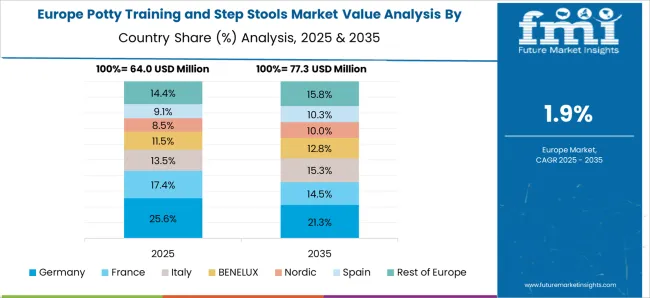
The potty training and step stools market in France is projected to grow at a 4.2% CAGR, driven by the demand for practical and ergonomic child development products. As French parents increasingly seek products that offer ease of use and safety, there is rising interest in high-quality, durable potty training products. Additionally, the growing awareness of early childhood development and parenting trends is further accelerating the adoption of potty training products and step stools. France’s strong preference for quality and design is influencing manufacturers to offer products that meet both functional and aesthetic needs.
The UK potty training and step stools market is expected to grow at a 3.8% CAGR, driven by the rising demand for child safety and development products. As parents increasingly prioritize early childhood development, there is a growing preference for potty training solutions that are easy to use, safe, and comfortable. The UK market is also benefiting from the increasing availability of innovative and aesthetically pleasing products that cater to the needs of modern families. The growing focus on hygiene and the desire for child-friendly home solutions is driving the adoption of potty training products and step stools in the country.
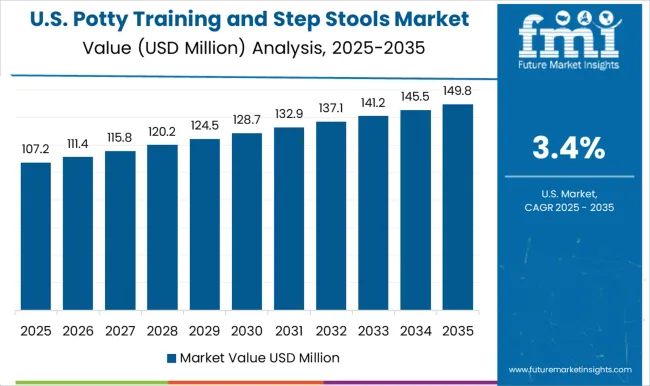
The USA potty training and step stools market is projected to grow at a 3.4% CAGR, supported by the rising awareness of early childhood development and the growing demand for products that support the potty training process. As parents seek high-quality, durable, and ergonomic products, the market for potty training and step stools is growing steadily. The availability of diverse product options, including those with child-friendly features and designs, is contributing to market expansion. The convenience of online shopping and increased product availability is further driving demand for potty training tools across the USA
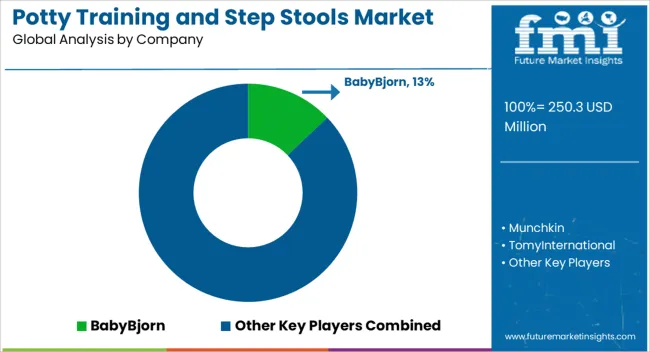
The potty training and step stools market is driven by prominent companies offering innovative, safe, and durable products designed to support toddlers during their potty training process. Baby Bjorn is a key player, providing high-quality potty training products, including comfortable and ergonomic potty chairs and stools, which focus on ease of use and safety. Munchkin offers a wide range of potty training solutions, known for their innovative designs and functionality, making the potty training experience enjoyable for both parents and children. Tomy International provides potty training and step stools that combine practicality with fun designs, ensuring they are both effective and child-friendly. OXO offers highly functional potty training products with an emphasis on ergonomics, easy-to-clean designs, and durability. Mattel, a leading toy manufacturer, also produces potty training accessories with a focus on safety and convenience, ensuring that their products align with their brand's reputation for quality. Kids2 specializes in creating practical, comfortable potty training stools and seats, often incorporating playful designs that make training less stressful for young children. Skip Hop is recognized for its fun and functional potty training solutions, focusing on safety, design, and the overall user experience. Ubbi offers high-quality potty training products with an emphasis on simplicity, functionality, and eco-friendly materials. BÉABA manufactures toddler-friendly potty training products designed for ease of use, with a strong focus on comfort and safety. Kolcraft offers sturdy, reliable potty training solutions, including step stools designed to aid in toddler independence. Regalo Baby provides affordable and reliable step stools, widely used in potty training and daily activities. Prince Lionheart manufactures innovative potty training products known for their high safety standards and unique designs. Dream Baby provide a variety of potty training solutions, focusing on comfort, safety, and ease of use. Gatvin Technologies also competes in the market, offering modern potty training solutions aimed at convenience and safety for toddlers and parents.
| Item | Value |
|---|---|
| Quantitative Units | USD 250.3 Million |
| Product Type | Potty training and Step stools |
| Material | Plastic, Wood, and Others (polypropylene, pinewood) |
| Pricing | Medium (15$-30$), Low (5$-15$), and High (Above 30$) |
| Age Group | Toddlers (2-5 years), Newborn (0-6 months), Infants (6 months- 2years), and Others (above 5 years) |
| End Use | Individual use and Commercial use |
| Distribution Channel | Online and Offline |
| Regions Covered | North America, Europe, Asia-Pacific, Latin America, Middle East & Africa |
| Country Covered | United States, Canada, Germany, France, United Kingdom, China, Japan, India, Brazil, South Africa |
| Key Companies Profiled | Baby Bjorn, Munchkin, Tomy International, OXO, Mattel, Kids2, Skip Hop, Ubbi, BÉABA, Kolcraft, Regalo Baby, Prince Lionheart, Dream Baby. |
The global potty training and step stools market is estimated to be valued at USD 250.3 million in 2025.
The market size for the potty training and step stools market is projected to reach USD 370.5 million by 2035.
The potty training and step stools market is expected to grow at a 4.0% CAGR between 2025 and 2035.
The key product types in potty training and step stools market are potty training, _potty chair, _toilet training seat, _3 in 1 seat, step stools, _single step stools, _dual step stools and _foldable stools.
In terms of material, plastic segment to command 51.7% share in the potty training and step stools market in 2025.






Full Research Suite comprises of:
Market outlook & trends analysis
Interviews & case studies
Strategic recommendations
Vendor profiles & capabilities analysis
5-year forecasts
8 regions and 60+ country-level data splits
Market segment data splits
12 months of continuous data updates
DELIVERED AS:
PDF EXCEL ONLINE
Training Shoes Market Analysis - Size, Trends & Forecast 2025 to 2035
Dog Training Equipment Market Size and Share Forecast Outlook 2025 to 2035
Golf Training Aids Market Analysis by Growth, Trends and Forecast from 2025 to 2035
Cross Training Shoes Market Size and Share Forecast Outlook 2025 to 2035
Sales Training and Onboarding Software Market Size and Share Forecast Outlook 2025 to 2035
Weight Training Market Analysis - Size, Share, and Forecast 2025 to 2035
AR and VR in Training Market Size and Share Forecast Outlook 2025 to 2035
Concrete Air Entraining Agents Market Size and Share Forecast Outlook 2025 to 2035
Leadership Training – AI-Powered Growth for Enterprises
Cognitive Assessment and Training Market Report – Trends & Growth Forecast 2024-2034
Stepper Motors Market
1-Step RT-PCR Kits Market Size and Share Forecast Outlook 2025 to 2035
Global One Step RT-qPCR Kits Market Analysis – Size, Share & Forecast 2024-2034
One-step ELISA Market
Anderson Cascade Impactor Market Size and Share Forecast Outlook 2025 to 2035
Andersen-Tawil Syndrome Treatment Market Trends - Growth & Future Prospects 2025 to 2035
Andro Supplements Market
Handheld Imaging Systems Market Size and Share Forecast Outlook 2025 to 2035
Sandwich Panel System Market Size and Share Forecast Outlook 2025 to 2035
Hand Tools Market Size and Share Forecast Outlook 2025 to 2035

Thank you!
You will receive an email from our Business Development Manager. Please be sure to check your SPAM/JUNK folder too.
Chat With
MaRIA